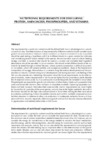Identificador persistente para citar o vincular este elemento:
https://accedacris.ulpgc.es/jspui/handle/10553/77150
| Título: | Nutritional requirements of fish larvae: protein, aminoacids, phospholipids, and vitamins | Autores/as: | Izquierdo, M. S. Robaina, L. |
Clasificación UNESCO: | 310502 Piscicultura | Fecha de publicación: | 2007 | Editor/a: | Universidad Católica de Temuco | Conferencia: | Proceeding workshop internacional. Producción de larvas de peces | Resumen: | The requirement for a particular nutrient could be defined both from a physiological or a practical point of view. The determination of requirements for different nutrients should consider some general recommendations: Optimal culture conditions as close to commercial scale as possible should be used, testing a hypothesis with 5 to 6 different levels for a given nutrient by triplicates and considering several factors related to the species, the environment, type of culture, feeding strategy and feed. A standard diet should be used as a control and complete feed ingredient descriptions should be provided. In larval nutrition, fish should be fed different levels of the nutrient to be tested through enriched life prey, whose nutrient composition is difficult to control, or microdiets, which still present stability and acceptance problems. Study of the biochemical composition of the eggs, the evolution of a nutrient along the embryo development and the conservation or loss of a nutrient along larval development and during starvation and feeding of the fish can also provide very interesting information about the larvae requirements. As for other types of nutrients, protein requirements in fish larvae are higher than for juveniles or adults. Besides the 10 essential amino acids, Tyr, Cys and taurine must be frequently be included in larval diets. Phospholipids are required for growth and utilization of other dietary lipids such as essential fatty acids and fat-soluble vitamins, their inclusion in microdiets markedly improving lipoprotein synthesis and lipid transport. Most described water-soluble vitamin requirements are much higher for larvae than for juveniles of the same species, not only due to the higher metabolic demand in the former, but also for the high ratio surface/volume in larval diets making the diets more prone to oxidation and leaching. Certain fat-soluble vitamins such as Vit E, markedly improved survival, but their elevation in absence of other anti-oxidants or in inadequate molecular forms as it happens with Vit A, not only negatively affect larval growth and survival but also induces alterations in pigmentation and skeleton deformities in fish larvae. | URI: | https://accedacris.ulpgc.es/handle/10553/77150 | ISBN: | 978-956-7019-34-2 | Fuente: | Proceeding workshop internacional. Producción de larvas de peces, 14-15 de Septiembre de 2006, 978-956-7019-34-2, p. 173-181 |
| Colección: | Actas de congresos |
Visitas
96
actualizado el 24-feb-2024
Descargas
35
actualizado el 24-feb-2024
Google ScholarTM
Verifica
Altmetric
Comparte
Exporta metadatos
Los elementos en ULPGC accedaCRIS están protegidos por derechos de autor con todos los derechos reservados, a menos que se indique lo contrario.
